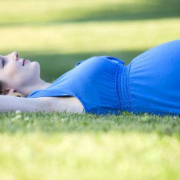Disc herniation in youngsters : what it is and how to prevent it
Three out of ten people suffer from persistent troublesome pain in the lower back that sometimes radiates even as far as the lower limbs, a pain that lasts for a year or more rather than disappearing in two or three weeks as is normally the case. Commonly referred to as “sciatica” or “lumbosciatica”, it is due to a condition called lumber disc herniation, which is a common cause of pain, including low back pain, and can significantly impact the quality of life of those affected. Unfortunately, this problem is now also seen in youngsters, too: “Over the years, changes in kids’ lifestyles — they spend increasingly more time sitting down and less and less in movement — have gone hand in hand with a growing prevalence of certain diseases, including lumbar disc herniation,” explains physiotherapist Sara Rossi Raccagni.
Let’s examine more closely what we are talking about. When material from the nucleus pulposus of an intervertebral disc is pushed through a tear in the fibrous ring (annulus) that forms its wall, and therefore out of its natural location, the disc is described as herniated. The intervertebral discs are the cushions located between the vertebrae, which absorb the loads to which the spine is subjected in the course of the day. The discs most affected by this degenerative process are the ones located between the fourth and fifth lumbar vertebrae and between the fifth lumbar vertebrae and the sacrum.
What are the risk factors that may contribute to the occurrence of disc herniation?
A recent study (Risk factors for lumbar disc herniation in adolescents and young adults: A case-control study ) investigated risk factors for lumbar disc herniation in 208 patients aged up to 25 years.
Obesity, which corresponds to a BMI (body mass index) greater than 30, has been found to be closely associated with the risk of lumbar disc herniation, probably due to the greater load exerted on the structures of the spine.
Poor posture when seated and spending more than six hours a day seated have both been identified as risk factors for the onset of disc herniation: “So-called lazy postures (sitting slouched back in a chair with your pelvis slid forward, or sitting bent over with your head and upper body leaning forward) put the spine under extra stress and increase the likelihood of disc degeneration, especially when they are maintained for a long time” Rossi Raccagni goes on. “Prior low back traumas also seem to increase the risk of disc herniation, especially in athletes because of the greater stress exerted on the structures of the spine. This applies especially when training (and the initial warm-up in particular) is not done correctly”.
Finally, another risk factor to bear in mind is heredity, in other words, whether there are cases of herniated disc in the family that could be linked to genetic anomalies, i.e., mutations in genes coding for extracellular matrix components, inflammatory markers and protein metabolism.
With the exception of the latter risk factor, on which we cannot intervene, all the others can be controlled by adopting a healthy lifestyle, reducing as much as possible the time spent sitting down and doing regular exercise as appropriate for your physique.
To reduce the risk of accidental trauma, it is a good idea to warm up completely before starting any sport-specific training. This warm-up increases the elasticity of your muscles and your spinal range of motion in all directions.
If you have a herniated disc, it is always advisable to consult doctors who specialise in the treatment of spinal disorders, as they can guide you step by step and also put you in the safe hands of expert physiotherapists.
The first-choice treatment is the type termed “conservative”. Conservative treatment must always be multidisciplinary and can include the use of drugs (anti-inflammatory and neurotrophic drugs), postural education, cognitive-behavioural therapy, manual therapy and exercises” Rossi Raccagni concludes. “If the pain fails to improve with conservative therapy or neurological deficits arise (stenosis and/or marked sensory deficits), then the patient might be referred for surgery.
Disc herniation can also be treated using “minimally invasive” methods, which are considered to fall mid-way between conservative and surgical treatments. They include oxygen-ozone therapy and epidural injections.


